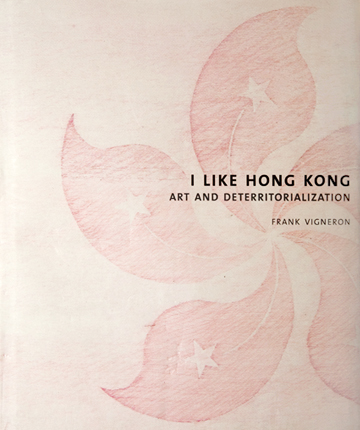I LIKE HONG KONG
| April 18, 2011 | Post In LEAP 8
Hong Kong-based art historian Frank Vigneron titles his highly personal account of contemporary art in the city after the infamous song “Kowloon, Hong Kong,” written and performed by a 1960s English-language local pop group called the Reynettes; juxtaposed on the cover of the book over a sketch of the bauhinia blossom that graces the Hong Kong flag, here executed by artist Wai Pong-yu, the tone is set for this fruitfully endearing exploration of contemporary culture. In tone and approach Vigneron does away with the fretful postcolonial pessimism of Ackar Abbas and his “culture of disappearance,” the highly critical reading of handover-era aesthetic anxiety that has become inestimably influential over subsequent cultural production and reception. In its place we find instead a variety of other influences: a deep and obvious affection for lived multiculturalism, an affinity with Continental theory, and an insistence on specific and concrete cosmopolitanism on a regional level. Not everything here works, but as a first step toward what we might call a positive problematic of cultural production in the Pearl River Delta, this volume certainly has something constructive to offer.

Though the text is structured around a series of major concepts, Vigneron essentially delivers a set of anecdotes in theory and practice that present an uneven but pleasurable picture of his journey through contemporary art and its interpretation. The reader imbibes a series of notes on concepts and specific works of art: painter Chow Chun Fai, for example, is served up between a page on Kristeva and Proust and a paragraph that makes reference to Wang Xingwei and Wang Qingsong; the idea of a “localized [or internal] diaspora” is presented through standard readings of Lacan and Barthes, who together make a convincing case for the code-switching between English, Cantonese, and Mandarin that plays such an integral role in Hong Kong social life; and Beijing hutongs are compared to both the Lek Yuen Bridge in Shatin and the preservation work of nineteenth-century French architect Eugene Emmanuel Viollet-le-Duc, all intertwined with a critique drawn from Rey Chow. That is to say, this is not the cohesive and rigorously genealogical tale of art in Hong Kong many have been waiting for, but it does situate that particular white whale of a project in a number of important ways, most notably by making a case for the viability of a pan-Pearl River Delta narrative influenced by global theoretical and aesthetic developments. Vigneron approaches his subjects— textual and visual— like an Old World sommelier might experiment with Cantonese cuisine, occasionally happening upon a stroke of brilliance but almost always remaining some distance above the bottom line.
I Like Hong Kong marks another step within the much-needed work of writing a history for Hong Kong art, something that could interact with the rapid development of Chinese contemporary art without either succumbing to annexation into this latter realm or ignoring the mainland arena entirely. Although he is not at all opposed to the marks of the mainland— in stark opposition, we must add, to many of his interlocutors— Vigneron is nevertheless something of a Hong Kong apologist, not in the sense that he asserts any manner of local superiority but rather in that he is sometimes slightly too willing to overlook the flaws and quirks of the work under analysis. One such case arises with the aforementioned bias against mainland Chinese artists that mars the political outlook of several artists treated in detail here; rather than raising this uncomfortable systemic issue, Vigneron instead chooses to treat artists like Kwan Sheung Chi and Hai Bo side by side— an arrangement to which, we might suspect, both artists might object. Nevertheless, this is a fundamentally serious work of criticism, one that opens up a fascinating question for future efforts: Vigneron is a trained and practicing art historian, but, as proclaimed in the subject heading classifications of the book and more than evident in its offhand approach to grouping and chronology, this is indubitably a work of art criticism. The author nevertheless makes explicit reference to a rejection of “subjective” value judgments, effectively abnegating his rights to the writing of history and following the accepted set of names and works proposed by the already weak institutions of display in Hong Kong: a dysfunctional museum, incestuous universities, and unchallenged private galleries.

